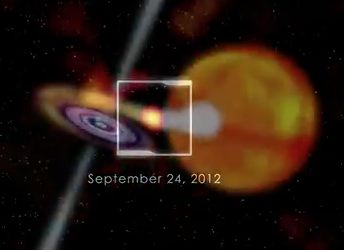Description
|
AUDIO:
Music
The Milky Way is a diffuse glow that marks the central plane of our home galaxy. It's brightest whenever the constellations Sagittarius and Scorpius are in view. Between them, we're looking toward the very center of the Milky Way. Thick dust clouds block our view of the central region in visible light, but satellites like NASA's Swift, which detect X-rays, can see straight through them. On September 16, 2012, NASA's Swift noticed a new and rapidly brightening X-ray source a few degrees from the galactic center. Astronomers quickly realized that this was a bright X-ray nova, something so rare that it's the first one Swift has seen. The object, now identified as Swift J1745-26 after its sky position reached peak brightness in high-energy X-rays in just over two days. At lower energies, such as those seen by Swift's X-ray telescope, it continued to brighten into October. Additional X-ray behavior told astronomers that the object at the center of this activity was a previously unknown black hole. The black hole is part of a binary system with a normal star like the sun. A stream of gas from the normal star flows into an accretion disk around the black hole. Usually in systems like these, the disk's gas spirals in toward the black hole, heats up greatly, and produces a steady X-ray glow. But with X-ray novae, there's a glitch in the disk. Gas builds up in the outer regions like water behind a dam. Once enough gas accumulates, which can take several decades, the dam breaks and a flood of gas surges toward the black hole, creating the X-ray nova outburst...and perhaps short-lived jets that blast particles outward at high-energy. Instabilities in gas disks regulate outbursts in a wide range of objects, highlighting the importance of understanding why some disks are more stable than others.
Music.
Beeping.
Beeping.
VIDEO:
Images from the Swift satellite, combined with illustrations.


